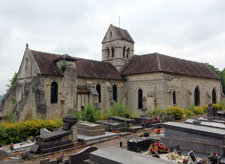Laigneville (Oise, France) - Saint-Remi
- Disclaimer
The dating found here is based on the work of John James, and is meant on this site to serve as a starting point. James' dating is derived from a system that uses his interpretation of the development of capitals over time as the basis for chronology, among other factors. His goal is to refine the dating to within years rather than decades. I have not fully embraced James' methodology, and will be developing this page from its current state to one which is admittedly more conservative. The relative expenditure values found in the Timeline are also based on James' work, and I believe these to be reasonably reliable. They are intended only to give a sense of the amount of work involved in each decade.
I have added the idea of the "project" as a way of separating work in buildings. In my mind, a "project" is a discrete section of work in a building that resulted from the one-time acquisition of funding. "Projects" are generally separated by at least a decade where no work was being done. It is my view that it would have been unwise to start a "project" that could not be finished and protected from the elements, and as such a "project" usually involved a wing or multiple wings of a building, from floor to roof. Rural churches, which could only secure small amounts of funding at irregular intervals, often were the result of many small projects, while the great churches, which benefitted from relatively consistent funding, may have involved only a few large projects.
I have added the idea of the "project" as a way of separating work in buildings. In my mind, a "project" is a discrete section of work in a building that resulted from the one-time acquisition of funding. "Projects" are generally separated by at least a decade where no work was being done. It is my view that it would have been unwise to start a "project" that could not be finished and protected from the elements, and as such a "project" usually involved a wing or multiple wings of a building, from floor to roof. Rural churches, which could only secure small amounts of funding at irregular intervals, often were the result of many small projects, while the great churches, which benefitted from relatively consistent funding, may have involved only a few large projects.
- Timeline with Relative Expenditure (if available, in building units)
 |
 |
 |
 |
 |
- Project A - 1070s - Phase 1 - crossing
Crossing that was smaller than the present one from presumption that the size of the tower would have been determined by that of the crossing, and because the capitals in the tower are from an earlier century to those in the crossing.
- Project A - 1080s - Phase 2 - tower
Tower.
- Project B - 1130s - Phase 3 - widen crossing
Opening into an apse that may have been built at this time; shafts, arch and continuous impost 3.84 metres from the floor; includes part of an opening to the north with imposts on each side of arch; wooden tie beam used; the opening was wider than the width of the bay under the tower.
- Project B - 1130s - Phase 4 - crossing
- Project C - 1160s - Phase 5 - east
Decision to widen the crossing under the tower to north and south; imposts 3.58 metres from the floor and so lower than entry into apse; capitals profiles show that the vaulted bay under the tower and the two bays of the north chapel were built together; this included tidying up the west wall of the south arm and its vaults with ribs that have a conje seating with rounded transition from spring to rib; at the junction with the nave where the piers for the arcade a\were built with the crossing; above the arches there is no continuity between the crossing piers and the nave walls and on the south the arch is stepped in from its support; this suggests that the projection for the arcade was placed with the crossing pier, but nothing more built at that time, a very common procedure; the same cornice was carried round the north and on west wall of the south but not to the south wall over the outcrop; there are unresolved complexities in this wall.
- Project C - 1160s - Phase 6 - w1
Lower nave walls and arches for future aisles butted onto western piers of crossing above the seating for the arch; designed for a wooden roof.
- Project D - 1180s - Phase 7 - nave (c)
Nave clerestory with massive buttresses to support the vaults between an external facing blocking the earlier arches and western portal with trefoil arch; stairs within buttress above the level of the aisle arches.
- Project E - Later - Phase 8 - nave (v)
2x2 bay eastern end.
